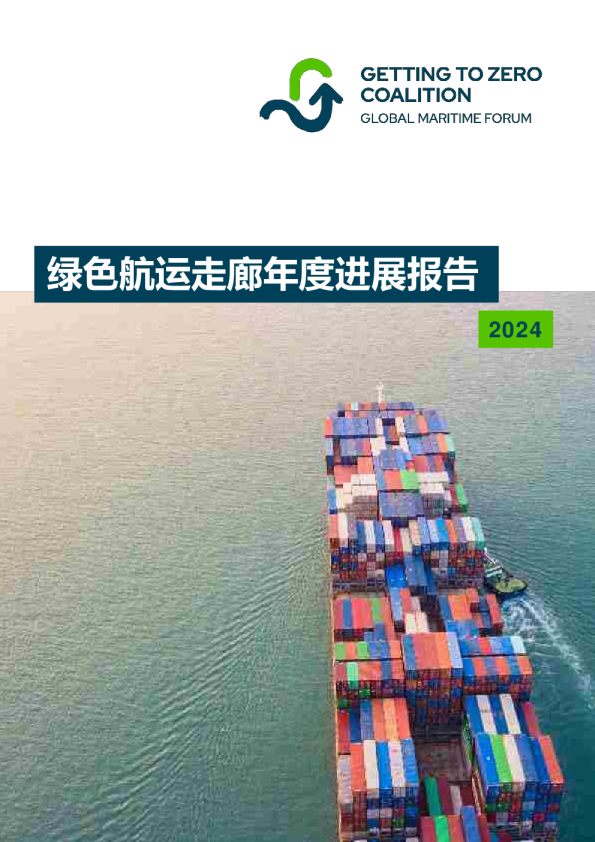加拿大绿色航运走廊
 AI智能总结
AI智能总结
海洋北保护协会 加拿大绿色航运走廊初步评估 最终报告 02|19June2023 本报告考虑了客户特定的指示和要求。本报告不面向任何第三方,且第三方不应依赖本报告,不对任何第三方承担任何责任。 职位编号289659-00 阿鲁普国际项目有限公司 8FitzroyStreet,伦敦W1T4BJ,英国 arup.com 内容 缩写词 1. 2. 2.1 2.2 3. 3.1 3.2 4. 4.1 4.2 4.3 1 引言2 加拿大绿色航运走廊4 绿色航运走廊旨在加速海运 脱碳化4 政府和行业已经表明了支持。 加拿大绿色航运走廊6 燃料用于绿色航运走廊8 生产低排放和零排放船用燃料8 动员燃料供应链12 总价值案例15 全面价值方法可能会阐明潜在的合作关系。 绿色航运走廊的益处15 绿道和更广泛的海运带来的好处 脱碳可能给加拿大带来的影响16 实现价值20 5.案例研究:不列颠哥伦比亚省,温哥华港和普雷里普特港21 5.1区域能源与资源21 5.2对低排放和零排放燃料的预计需求23 5.3温哥华港26 5.4普雷斯科特港33 6.案例研究:新斯科舍省和哈利法克斯港40 6.1区域能源与资源40 6.2对低排放和零排放燃料的预计需求42 6.3哈利法克斯港44 7.摘要50 8.参考文献52 |02|19June2023|Arup国际项目有限公司 缩写 AIS自动识别系统 BC不列颠哥伦比亚省 计算机辅助设计(Computer-AidedDesign)加拿大元 碳捕集与封存碳捕集与封存CMC商会 CO二氧化碳 2 COe二氧化碳当量 2 联合国气候变化框架公约缔约方大会 直接聚合电路(DirectlyAddressedComparator )直接空气捕获 环境、社会和治理(Environmental,Social,andGovernance)环境、社会和治理 国内生产总值国内生产总值GW吉瓦-瓦特H氢 2 HFO重油 HFOe重油(能源)当量国际海事组织国际海事组织 每千吨产品(ktpa)每年千吨级液化天然气液化天然气 协议备忘录谅解备忘录 MWMega-WattNS新斯科舍省购电协议购电协议 研究与开发(ResearchandDevelopment)研究与开发 RVA实际增加值 滚装滚卸滚装/滚卸TEU吨等效单位美国美国 美元美元 VLSFO非常低硫燃料油 1.引言 需要采取加速行动来应对航运领域的温室气体排放。 加拿大商业航运活动估计每年对加拿大经济贡献约300亿美元[1]。与此同时,在加拿大水域运营的船舶在2019年产生了超过1300万吨的二氧化碳排放量[2],约占全球的1.7%。 2 加拿大总的温室气体排放量,直接导致全球气候变化。这些船只还会产生数千吨的空气污染物,影响港口和沿海社区的健康,污染海洋,并且自身也可能产生重大的气候影响。 能源效率和尾气处理技术代表了一定的进步;然而,它们只能对排放量进行微小的减少。若要实现深层温室气体排放的削减,全球必须从化石燃料转向零排放的替代品。从本世纪末开始,广泛使用这些燃料将需要遵循与《巴黎协定》目标一致的脱碳轨迹。然而,尽管在取得进展,这些燃料的可用性仍然极低,而高昂的成本使它们在可用地区变得不经济。在短期内进行协调行动可以帮助开发和展示这些燃料的技术、法规和商业可行性,为这些燃料在行业内后续的普及奠定基础 。 需要紧急过渡到化石燃料的替代方案。 本报告使用“零排放燃料”一词指代那些全生命周期温室气体排放量为零的燃料。在本报告中,“低排放燃料”指那些生命周期温室气体强度为20gCO2e/MJ的燃料,这大约比传统燃料低80%。 2 航运燃料油。这些术语在第三部分有更详细的讨论。 大部分针对航运排放的应对活动都是在国际海事组织(IMO)层面进行的。国际海事组织已经引入了针对空气污染物排放的法规,并推进了提高船舶能源效率的措施,从而减少温室气体排放。在国家层面,加拿大承诺到2050年实现净零排放,并通过2030年减排计划,正在制定一项国家行动计划,以使海洋部门能够减少其排放,包括与利益相关者就能源效率要求和国内船只的碳强度要求进行合作,这些要求与国际船只的要求相一致。 这一转型代表了一个重大的基础设施机遇,加拿大处于有利位置以最大化其收益。 所需的投资资金来使国际航运在2050年实现脱碳已估计高达1.6万亿美元,其中约87%将用于发展燃料生产设施和其他陆上基础设施[3] 。在许多情况下,这些基础设施将完全新建,包括可再生能源发电、氢电解器和燃料合成厂。这为世界各国实现其环境目标、推动经济繁荣、实现社会共同效益以及保护自身免受化石燃料产业退出影响提供了一个重大机遇。作为拥有熟练劳动力和丰富的土地及自然资源储备的现有能源生产国,加拿大有很好的条件抓住成为零排放燃料生产者甚至出口者的机遇。 绿色航运走廊可加速加拿大的海事脱碳进程。 各种技术、监管和商业障碍已阻碍了航运行业至今对低排放和零排放燃料的采用。绿色航运通道是一种将航运和燃料价值链上的各种参与者聚集在一起共同解决这些障碍的方式。在此过程中,通道旨在展示在特定航线上使用这些燃料的可行性,从而在中短期催化更广泛地采用这些燃料。加拿大港口已经宣布了若干个走廊合作伙伴关系,加拿大交通部已发布了一套国家绿色航运通道框架,以指导其实施。 最后,我们应用了一种“总体价值”的构架方法来探讨通过有效交付这项新基础设施所能实现的一些关键财务、社会和经济协同效益。 本报告旨在展示加拿大所面临的机会。 北极海公司已委托阿鲁普公司进行初步评估,以探讨绿色航运走廊— —以及更广泛的航运脱碳——在加拿大可能产生的影响。阿鲁普的研究得到了劳氏船级社海事脱碳中心的分析支持,该中心估计在三种不同场景下,使用加拿大三个港口,航运低排放和零排放燃料的潜在发展情况。 在本报告中,我们介绍了绿色航运走廊的背景、新兴倡议的特点以及这些特点如何在加拿大环境中得到应用。我们探讨了主要低排放和零排放船用燃料的生产途径及其原料,这些途径具有支持航运长期脱碳的潜力。我们描述了影响它们在不同地区适用性的关键因素。我们还探讨了如何利用绿色走廊伙伴关系来调动燃料生产价值链中的关键利益相关者群体,以推动这些燃料的采用。 劳埃德船级社基于船舶交通数据和关于需求发展的前瞻性假设,对不同场景下加拿大三个不同港口的低排放和零排放燃料的潜在需求演变进行了估算。我们估算出满足需求所需的能源和燃料生产基础设施的规模、类型和资本成本。我们描述了三个港口的典型燃料供应类型,以此作为探索它们在满足这一需求时面临的挑战和机遇的手段。 加拿大绿色发展走廊 2.1绿色航运走廊旨在加速航运业的脱碳进程。 尽管航运业在减少碳排放方面的雄心日益增长,但众多障碍阻碍着零排放海洋燃料的开发和部署。绿色航运走廊是帮助解决这些问题并加速行业脱碳的一种方式。 但绿色航运通道中零排放船舶的部署是共同目标,方法各异 绿色航运走廊的概念首次于2021年出现,并在COP26会议期间的克莱德班克宣言中被提出来,现在已有包括加拿大在内的24个国家签署 。该宣言概述了签署国共同的目标,即在十年中至少建立六个绿色航运走廊,包括国际和国内航线。绿色走廊的概念是由全球海事论坛(GMF)及其在《下一波》报告[4]中的合作伙伴研究发展起来的。该报告对绿色航运走廊的核心定义如下: 特定航运路线,在这些路线中,零排放船只运营的技术、经济和法规可行性由公共和私人行动的结合所推动。 这在全球范围内引发了一股绿色航运走廊承诺的浪潮,对定义的诠释各有不同。其他定义包括: 证明了并得到了支持。”英国船舶减排办公室 (英国海岸)[6] 由一组公司、国家或机构采取的专注行动/意图,涉及整个零排放航运价值链,旨在在整个价值链中交付一个商业化产品/服务。”麦家恩·莫勒中心[7] 重要的是将绿色航运通道视为催化零排放航运可行性的起步阶段项目 ,并与国家及国际层面的政策制定同步进行。如图1所示,这种双管齐下的方法可在后续的扩散阶段迅速得到应用。 图1-转型环境中的绿色廊道 海上航线展示低碳和零排放生命周期燃料及技术,旨在支持该走廊在所有方面实现零温室气体排放,并力争在2050年之前实现整个行业的脱碳。美国国务院绿色航线走廊框架[5] 绿色航运走廊是指两个或更多港口之间的海事航线,沿此航线行驶的船舶使用可扩展的零排放能源。 (改编自全球海事论坛[8]) 首次动工走廊可以帮助航运业达到“转折点”。零排放燃料的采用 在其核心,绿色航运走廊旨在动员整个价值链上的利益相关者,以解决为零排放燃料采用所面临的障碍。这些举措的焦点在于短期到中期所发生的燃料转型初期阶段,同时关注技术和商业的准备工作。 所需解决方案仍在发展中。通过培育这一发展并促进零排放航运燃料的首次采用,这些举措可以为整个行业实现“临界点”,在该临界点上 ,它们开始快速扩张而无需这种有针对性的支持和协调。据估计[9],如果到2030年,国际航运业使用的燃料中有5%和国内航运业使用的燃料中有15%具有零生命周期温室气体排放,那么就可以跨越这个临界点;帮助将航运的脱碳轨迹与《巴黎协定》目标对齐。 合作伙伴与领导层 领导层和参与绿色航运走廊倡议的关键合作伙伴对其重点和活动具有重大影响。例如,由政府和公私部门领导的倡议可能侧重于发掘经济和社会发展的机会,而由行业领导的倡议可能寻求为其合作伙伴组织定位以开发新的商业模式。合作伙伴的构成也同样重要,因为它将影响在价值链中集中精力的方向,要么关注燃料供应,要么动员需求。 航线 航道可能专注于在两个港口之间运营的船只(端到端 ),在或一个或多个港口周围或之间(集群)或者在整个地理区域(区域性)。航线的范围将对航道实施的复杂性产生影响。在某些情况下,可能通过评估整个区域的航线开始一项倡议,然后再集中精力在最有前途的端到端 路由或集群。 治理结构、航运路线和目标在各走廊倡议之间差异很大。 数十个绿色航运走廊倡议已在全球范围内宣布并正在开发中;其中一些涉及加拿大港口。预计在未来几个月和几年内,随着各国履行克莱德班克宣言下的义务,这一数字将迅速增加。这些倡议在领导方式、考察的航线类型、总体目标和目标以及应用于其发展的方法上各不相同。所有倡议都处于早期阶段,目前尚无法衡量它们的相对成功。然而,在走廊伙伴关系和更广泛的利益相关者群体发展过程中,存在一个分享经验教训的机会。 目标和目的 走廊关注渐进式减排可能风险部署效率措施或过渡燃料,这些措施或燃料可能不支持长期采用零碳燃料解决方案。走廊可能采取混合方法实现其目标,在一段时间内同时聚焦于减排和多方利益相关者的努力。关于更具挑战性的零碳主题的伙伴关系 燃料摄取。 通过了解不同方法的好处和挑战,加拿大利益相关者可以确保涉及加拿大港口的绿色航运通道最有效地促进大规模实现零排放燃料的长期采用 ,并使加拿大能够从这一转型中获益。 图2-现有绿色航运走廊项目的回顾 2.2政府和行业已经在加拿大绿色航运走廊方面表现出支持 。 政府已表明对航运脱碳的强烈支持。 2021年,加拿大通过了《净零排放责任法案》,该法案确立了到205 0年实现所有领域净零温室气体排放的承诺。该法案设立了一个具有法律约束力的过程,以设定每五年一次的减排目标,并制定了可行的计划以实现这些目标。 《2030年减排计划》[10],这是2022年3月发布的净零排放立法下的第一份计划,概述了加拿大到2030年将排放量削减至2005年水平的40 -45%,并继续努力到2050年实现净零排放的目标。该计划包括对所有经济部门采取的措施,包括支持清洁能源项目如风能和太阳能,开发零排放燃料,一个交通脱碳计划,以及承诺将油气生产中的甲烷排放量减少75%。对于海事部门,该计划包括承诺制定一份“国家行动计划”,以减少海洋部门的排放,以及采取直接措施减少政府运营船只的排放。 加拿大已加入《零排放航运宣言》[12],该宣言的合作伙伴同意加强全球努力,确保到2050




